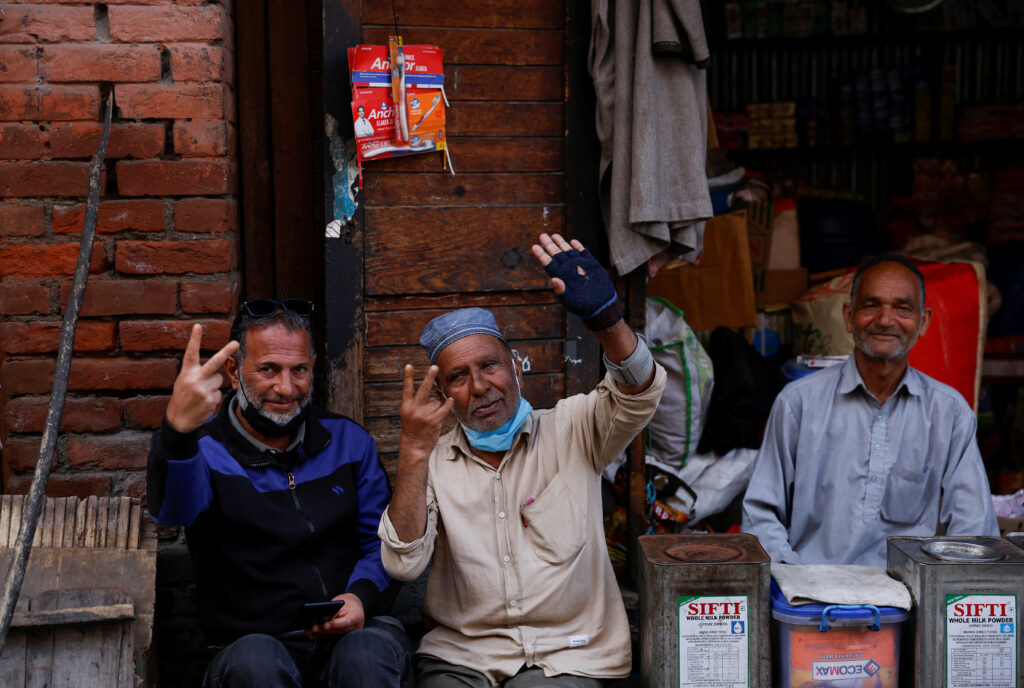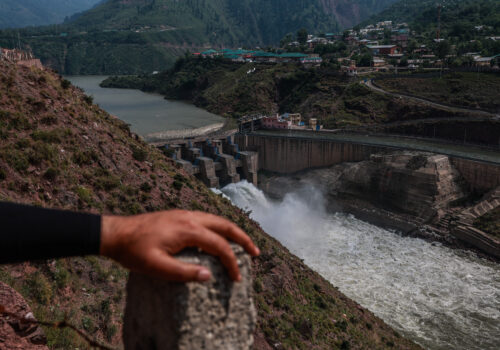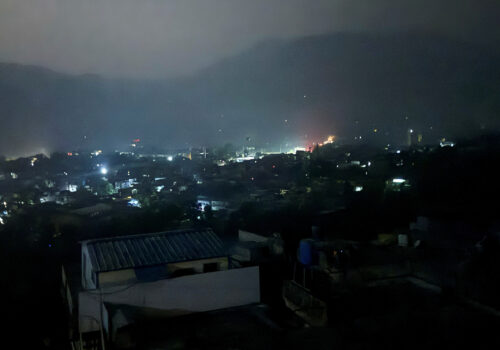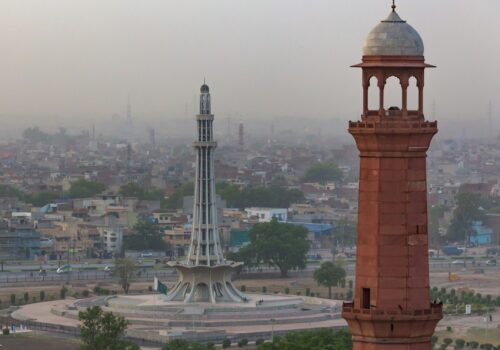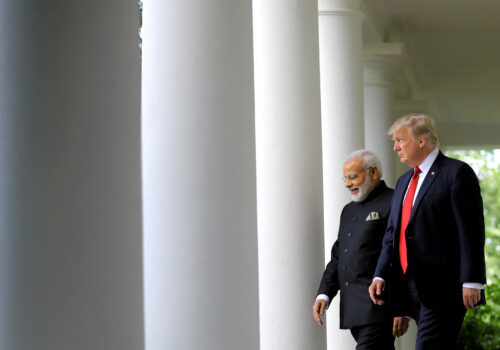The skies have gone quiet—mostly. India and Pakistan announced a sudden cease-fire on Saturday after four days of trading increasingly severe strikes, centered around the disputed area of Kashmir. Hours later, reports emerged of shots fired on both sides, raising the question of whether this fragile cease-fire will hold. And there are plenty more questions about this standoff between nuclear-armed neighbors: How did the possible truce happen? What role is the United States playing? Is there a path to long-term peace? With the fog of war still hovering over South Asia, our experts explore the answers below.
This post will be updated as the story develops and more expert reactions come in.
Click to jump to an expert analysis:
Alex Plitsas: The world cannot afford to wait until the brink again
Srujan Palkar: The US should correct its strategic imbalance in South Asia
Shuja Nawaz: By focusing on water, extremism, and trade, the cease-fire can become an enduring peace
Rudabeh Shahid: What the cease-fire and its violations mean for South Asia’s non-nuclear states
Manal Fatima: India suffers a reputational blow, while the fate of Kashmiris remains perilous
The world cannot afford to wait until the brink again
The recent cease-fire between India and Pakistan marks a critical juncture in averting a potentially catastrophic escalation in South Asia. The decades-long rivalry, rooted in territorial disputes over Kashmir and fueled by mutual distrust, has repeatedly brought these nuclear-armed neighbors to the brink. This latest de-escalation, while fragile, underscores the urgent need for restraint and timely international intervention, both of which were dangerously absent as tensions spiraled.
The conflict had gone too far. Cross-border skirmishes, artillery exchanges, and inflammatory rhetoric intensified, with each side miscalculating the other’s resolve. India’s aggressive posturing, often tied to domestic political pressures, clashed with Pakistan’s defensive yet provocative responses. Both nations’ militaries, equipped with advanced weaponry and nuclear arsenals, risked missteps that could have triggered a broader conflict. The 2019 Balakot airstrike and subsequent retaliation demonstrated how quickly localized incidents can escalate, yet lessons from that crisis were poorly applied. Mismanagement was evident in the failure to prioritize diplomacy over brinkmanship, with both governments amplifying nationalist sentiments rather than seeking de-escalation.
World powers, particularly the United States, China, and the United Nations, were alarmingly slow to intervene. Their delayed response allowed the situation to fester, emboldening hardline factions and undermining moderates who sought dialogue. Global attention, distracted by other crises, underestimated the stakes of a potential India-Pakistan war, which could destabilize the region and disrupt global security. The cease-fire, brokered only after significant loss of life and economic strain, highlights the need for proactive international mediation.
This truce is not a solution but a reprieve. It averts immediate disaster, preserves economic stability, and opens a window for dialogue. However, without sustained global pressure and a commitment to address root causes like Kashmir, the cycle of escalation will persist. The world cannot afford to wait until the brink again.
—Alex Plitsas is a nonresident senior fellow with the Scowcroft Middle East Security Initiative, the head of the Atlantic Council’s Counterterrorism Project, and a former chief of sensitive activities for special operations and combating terrorism in the Office of the Secretary of Defense.
The US should correct its strategic imbalance in South Asia
Saturday’s cease-fire had a degree of US involvement. But India’s recent counterterrorism operations under Operation Sindoor, followed by retaliatory strikes and escalation, have exposed an imbalance in US policy toward South Asia. As negotiations continue in the coming weeks, there is one policy shift the United States could take that would ensure it builds trust with India while putting the onus on the Pakistani establishment to play its part in counterterrorism—and that is revoking Pakistan’s Major Non-NATO Ally (MNNA) status.
Despite deepening ties with India—a key Indo-Pacific partner—the United States continues to extend MNNA status to Pakistan, a country whose military-intelligence apparatus has long tolerated, if not enabled, cross-border terrorism. The recent Pahalgam attack, timed with a high-level US visit, highlights a recurring pattern of militant violence during diplomatic moments—echoing the 2000 Chittisinghpura massacre on the eve of a visit by President Bill Clinton.
From New Delhi’s perspective, the MNNA designation for Pakistan—which India does not have—sends contradictory signals. While US policymakers express solidarity with India during crises, they continue to offer Pakistan privileged military status without conditioning it on measurable counterterrorism compliance. This undermines deterrence, weakens regional crisis management, and emboldens actors who operate outside the norms of accountability from Pakistani soil.
The original justification for Pakistan’s MNNA status—logistical cooperation during the US war in Afghanistan—has expired. Today, China is Pakistan’s primary defense partner, and US assistance has largely dried up. Revoking MNNA would rebalance Washington’s ties with Islamabad and recognize strategic realities. It would also reinforce India’s role as an independent regional security provider, not dependent on US largesse, while establishing that Washington will hinge its support on alignment with counterterrorism and regional stability goals.
—Srujan Palkar is the global India fellow at the Atlantic Council.
By focusing on water, extremism, and trade, the cease-fire can become an enduring peace
Now that both India and Pakistan have executed their military responses to each other’s real or perceived actions against the other in Kashmir, good sense has prevailed in the shape of a cease-fire. If the announcement holds, this stops the ratcheting up of hostilities that were putting both nuclear-armed rivals on a steep escalation ladder. Historically, both sides try to gain some tactical advantages by extending the cease-fire limits. And there are many trigger-happy local commanders on both sides of the line of control in Kashmir, which would explain reports of clashes in the hours after the cease-fire announcement.
I am hearing from Pakistani sources that the agreement to cease hostilities emerged after closed and direct talks between the directors general of military operations of both armies and representatives of the two national security advisors. It helped that in the case of Pakistan, the national security advisor, Lt. Gen. Asim Malik, was also the current director general of the Inter-Services Intelligence (likely preparing himself for that generally civilian role post-retirement in a few months). Helping the process to put the lid on this regional flashpoint was the behind-the-scenes encouragement of US President Donald Trump, his Secretary of State Marco Rubio, and possibly Saudi Arabia.
What next? Having raised domestic emotions to a high pitch, leaders on both sides will want to take a much-needed pause and then begin the process of what Rubio identified as the beginning of “talks on a broad set of issues at a neutral site.” It will be interesting to see what is considered a neutral site. The Gulf is one possibility.
Three main items should be on the agenda.
1. The Indus Basin Water Treaty
Front and center should be the discussion of the effects of climate change on both India and Pakistan and the need to update the Indus Basin Water Treaty, originally agreed upon with US help and under the aegis of the World Bank. That treaty, signed in 1960, took nine years of negotiation. Both countries have been dancing around the shared waters issue in the past. India recently unilaterally abrogated the treaty—a debatable action. Regardless, the Himalayan and Karakoram glaciers feeding their rivers are declining, and time is running out for measures to counteract that reality. Both nations will suffer the consequences of dying waterways. Moreover, the shared aquifers of the Indian and Pakistani Punjabs badly need recharging. The misuse of tubewells has dropped the water tables, and overwatering has produced waterlogging and salinity. Combined efforts to revive underground water resources will help fight climate change. Otherwise, agriculture will suffer, and the population may die of thirst. …
Read more from Shuja Nawaz, a distinguished fellow at the Atlantic Council’s South Asia Center, here:
What the cease-fire and its violations mean for South Asia’s non-nuclear states
The recently brokered cease-fire between India and Pakistan, hailed just this morning as a sign of returning stability, was violated shortly thereafter—underscoring the fragility of such diplomatic pauses in South Asia. The shaky agreement, facilitated by the Trump administration, highlights a deeper regional truth: while the logic of Mutually Assured Destruction may avert full-scale war, it does little to halt the cycles of escalation driven by mistrust and historical grievance.
In a region marked by volatility and deep-seated animosity, cease-fires are never just about halting gunfire. They are signals of restraint, tactical pause, or strategic recalibration. Their violation carries meaning too: It hardens political rhetoric, narrows diplomatic space, and amplifies insecurity far beyond the Line of Control in Kashmir. For South Asia’s non-nuclear states, this renewed conflict is more than a bilateral affair. It is a regional stress test with asymmetric consequences.
In Bangladesh, where an interim government has replaced Sheikh Hasina’s long-standing pro-India administration, anti-India sentiment has intensified further. The recent protests, which have successfully pressured the interim government to ban the Awami League under the country’s Anti-Terrorism Act, are now also inflected with broader regional anger. India’s posture during and after the cease-fire may be seen as coercive, deepening the backlash and weakening Dhaka’s willingness to align with New Delhi on strategic matters.
Sri Lanka, navigating domestic fragility and a delicate geopolitical balance, will attempt to remain neutral. Yet neutrality is not invisibility. Muslim communities in the country remain attuned to wider Islamophobic narratives, and Indian pressure may provoke political ripples. Meanwhile, China’s deepening footprint in Colombo further constrains Sri Lanka’s room for maneuver.
Nepal’s balancing act between India and China might also come under strain. Heavily reliant on Indian trade and remittances, India may grow increasingly wary of Kathmandu’s neutrality, especially amid heightened security anxieties. In this environment, Nepal’s neutrality could be interpreted as disloyalty, thereby placing the landlocked country in an increasingly untenable position.
Bhutan, while closely tied to India through the 1949 Treaty of Friendship, is not insulated either. Bhutan may again face increased Chinese pressure along its contested border, particularly if India redirects strategic focus northward—just as it did during the Doklam standoff in 2017.
The Maldives, too, might face growing pressure. As India reasserts its strategic role in the Indian Ocean, Malé’s policy of hedging between New Delhi and Beijing becomes harder to sustain. Domestic political undercurrents, including Islamist sentiment, may complicate Malé’s ability to respond to Indian pressure without facing internal pushback.
Above all, the shaky cease-fire underscores the chronic dysfunction of South Asia’s regional institutions. The South Asian Association for Regional Cooperation (SAARC) remains paralyzed, thereby lacking any mechanism for mediation, de-escalation, or collective response. Non-nuclear South Asian countries remain vulnerable to the centrifugal pull of India-Pakistan tensions, without a regional forum to cushion the fallout.
For the United States, the original cease-fire may have seemed like a diplomatic win. Saturday night’s violations, however, reveal the limits of transactional diplomacy. More significantly, it reflects a broader regional transformation: A more assertive regional posture by India will be perceived by non-nuclear neighbors as encroaching on their strategic autonomy—prompting deeper engagement with China as a counterbalance.
The real challenge is no longer merely avoiding the next crisis. It is about envisioning a regional order where diplomacy is consistent, non-nuclear South Asian states are not treated as collateral, and cooperation—not coercion—defines the regional norm.
—Rudabeh Shahid is a nonresident senior fellow at the Atlantic Council’s South Asia Center.
India suffers a reputational blow, while the fate of Kashmiris remains perilous
Saturday’s US-mediated cease-fire between India and Pakistan is a welcome development after a tense week that brought South Asia alarmingly close to a broader military confrontation. This recent exchange revealed not only the heightened lethality of modern warfare between the two nuclear-armed neighbors, far surpassing past skirmishes, but also reinforced a recurring pattern in contemporary conflicts—the emergence of social media as a significant new front. With widespread misinformation circulating, the narrative war was self-evident. Against this backdrop, Pakistan lifted its fifteen-month ban on X, while India ordered the takedown of over eight thousand X accounts for allegedly spreading disinformation.
However, this pause also invites deeper scrutiny into the outcomes of the past few days. India’s decision to launch airstrikes based on unproven allegations of Pakistani involvement in the tragic April 22 Pahalgam massacre naturally raises questions about their effectiveness. Prime Minister Narendra Modi’s India, eager to assert its role as a rising global power, arguably emerges from this crisis with a dented posture. Reports confirm the loss of at least two Indian military aircraft, including a French Rafale reportedly brought down by Pakistan’s Chinese-made J-10. Analysts have viewed the downing of the Rafale by a comparatively lower-cost Chinese aircraft as a blow to India’s defense credibility and a sign of tactical underperformance. Additionally, while some Indian media outlets circulated lists of terrorists allegedly killed in the initial strikes under Operation Sindoor—individuals linked to Jaish-e-Muhammad and Lashkar-e-Taiba—the unclear results of the operation make it difficult to ascertain New Delhi’s actual achievements and the effectiveness of these measures in realizing its intended goals.
Interestingly, Pakistan’s government finds itself on a relatively stronger footing. It has been under considerable scrutiny in recent months, particularly following the contentious 2024 general elections, or reasons including its handling of unrest in Balochistan and Balochi human rights activists, and its dealings with internal opposition. The external threat appeared to unify fractured political forces domestically. Amid this, the Pakistani Supreme Court’s controversial decision to allow civilians accused in the May 9, 2023 riots to be tried in military courts simply faded into the background as nationalist fervor dominated the country’s political atmosphere.
On the international/diplomatic front, Islamabad also appears to hold an advantage over New Delhi, which seems displeased with the Trump administration’s tone in mediations, viewing it as unfairly equating Pakistan with India. Further, Trump’s commitment to work with both countries “to see if … a solution can be arrived at concerning Kashmir” aligned more with Islamabad’s preference for international involvement rather than New Delhi’s desire to keep it a bilateral matter.
However, the fate of Kashmiris still hangs perilously between the two countries. While the ceasefire may have halted the immediate escalation toward all-out war, unrest in the disputed territory and the deeper conflict persist. For Kashmiris, caught between militants, military crackdowns, and political repression, the reality remains largely unchanged. In fact, there is a potential for an increase in the crackdown that followed the April terrorist attack by the Indian government, and within the ambiguous category of “suspected” terrorists, many may be unjustly targeted.
—Manal Fatima is an assistant director at the Atlantic Council’s Scowcroft Middle East Security Initiative.
Further reading
Tue, May 6, 2025
Experts react: India just launched airstrikes against Pakistan. What’s next?
New Atlanticist By
Atlantic Council experts share insights on India's missile strikes on Pakistan, which came two weeks after a terrorist attack targeting Indians in Pahalgam.
Tue, Apr 1, 2025
Rescuing Pakistan’s economy
Issue Brief By
For decades, Pakistan has struggled with a declining standard of living, skyrocketing public debt, and economic policies that have failed to address the root causes of its stagnation.
Mon, Feb 10, 2025
The continent-spanning win Trump can secure with Modi
New Atlanticist By William F. Wechsler
When the Indian prime minister visits the White House this week, high on the agenda should be the India-Middle East-Europe Economic Corridor (IMEC).
Image: Kashmiri men react after the ceasefire announcement between India and Pakistan, in Srinagar May 10, 2025. REUTERS/Sharafat Ali
